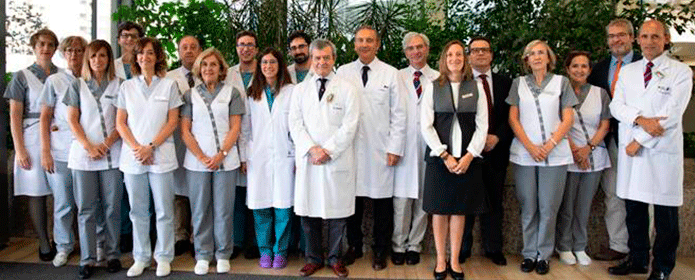Urologists at Clínica Universidad de Navarra achieve 97% success rate in prostate tumor control with focal therapy
The Urology team has the longest follow-up in Spain of patients treated with this new procedure, with a median of 15 months, supported by fusion biopsy diagnosis.

The Urology team at Clínica Universidad de Navarra achieves a 97% success rate in the control of prostate tumor treated with focal therapy and detected by MRI/ultrasound fusion biopsy, both state-of-the-art non-invasive procedures.
Clínica's specialists have treated more than 35 prostate cancer patients with these new techniques, one of the largest series in Spain. Moreover, the follow-up of these patients is the longest in the country, with a median of 15 months.
In addition to these procedures, we have extensive experience in robotic surgery of the same tumor for more advanced cases in which radical prostate surgery is essential, ensuring minimal invasion and maximum precision.
As Dr. Bernardino Miñana, co-director of the Clinic's Urology department , together with Dr. Ignacio Pascual, points out, "our team handles all the techniques existing today for the treatment of prostate cancer in all its stages". In this line, the physician highlights the handling of the Da Vinci robot with an experience of more than 400 patients, one of the most extensive series in Spain in this cancer.
Prostate tumor is the tumor with the highest incidence in the Spanish male population, with more than 30,000 new patients per year, and the one with the highest number of cases in the population as a whole. Hence, progress in its early diagnosis and treatment has been and continues to be a priority. Associated with age, prostate cancer is the fourth most frequent tumor worldwide, according to data of the Spanish Society of Medical Oncology(SEOM).
Advances in diagnostics: fusion biopsyAs Dr. Miñana points out, prostate cancer "has been the only solid tumor impossible to visualize using conventional imaging techniques". Until recently, the conventional diagnostic method has been blind transrectal biopsy. So if the result was positive, the agreed treatment was radical surgery (total removal) of the prostate or radiotherapy in its different variants.
The new diagnostic procedures through fusion of magnetic resonance imaging and high-end ultrasound have made it possible, through the perineum, to biopsy suspicious areas. "In this way we can know whether or not the area corresponds to a tumor.
Focal therapyIf a tumor is detected, the Clinic's team may advise the patient on a precision treatment, focal therapy, applied only to the tumor area. This is a procedure specifically aimed at single, non-aggressive tumors, characterized by fusion biopsy. In total, they account for an estimated 20% of prostate cancer cases.
To apply focal therapy, the irreversible electroporation technique is used, which consists of generating an electric field that preserves blood vessels and nerve tissue. It is applied by introducing through the perineum (the same route by which the biopsy was performed) a series of needles that are placed to delimit the lesion.
An electric current is passed through them, which destroys only the damaged tissue. This makes it possible to treat only the part of the prostate affected by the tumor and to keep the area of healthy tissue intact.
With this procedure the main adverse effects that can occur as a consequence of radical prostate surgery are avoided, among which the repercussions on continence and erectile function stand out. To date, Dr. Miñana points out, "we are the team with the longest experience in the application of focal therapy and the longest patient follow-up in Spain".
Robotic surgeryIf the prostate tumor is very extensive or has multiple foci, the indicated treatment is radical surgery using the Da Vinci robotic system. This high-precision procedure "offers the maximum guarantee of preserving urinary and sexual function," the specialist points out.
The selection of one therapy or another will always depend on the results obtained in the fusion biopsy, which provides information on the presence or absence of tumor, its location, the existence of one or more foci and its aggressiveness.
"In the Clinic's team we are experts in the whole range of techniques so that we aim to obtain as much information as possible to be able to offer each patient the treatment that may be best for his or her case," concludes the urologist.
